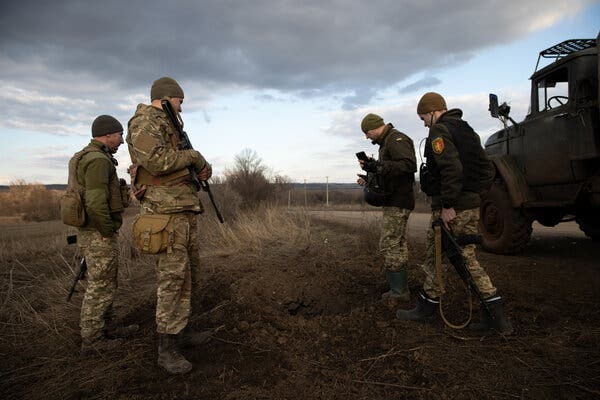
With the dispatch of armed forces by Russia and the promise of sanctions by the United States, the Ukraine conflict entered a perilous new chapter on Tuesday as the path to a diplomatic solution quickly narrowed.
President Vladimir V. Putin of Russia has been unsparing in terms of what lies ahead, calling Ukraine little more than a “puppet” of the United States, and Kyiv’s leaders solely responsible for whatever “bloodshed” may come next. Mr. Putin has also raised the specter of fighting after ordering troops to the two breakaway regions of Ukraine that Russia just recognized.
“As for those who captured and are holding on to power in Kyiv,” he said, referring to the Ukrainian capital, “we demand that they immediately cease military action.”
Ukraine’s leaders braced for the possibility of an intense fight to defend their territory, offering a somber message to troops on Tuesday. “Ahead will be a difficult trial,” the defense minister, Oleksiy Reznikov, said in a statement released by the military. “There will be losses. You will have to go through pain and overcome fear and despondency.”
President Volodymyr Zelensky of Ukraine continued to play down the threat of any Russian invasion, saying on Tuesday, “We believe that there will be no powerful war against Ukraine and there will be no wide escalation on the part of the Russian Federation.”
He added, however, “If it will, martial law will be imposed.”
White House officials have said that President Biden will impose economic sanctions on the separatist regions of Ukraine, and that a further Western response will be announced on Tuesday. By then, several of Mr. Biden’s aides said, they already expected to see Russian forces rolling over the border into Ukraine, crossing the line that Mr. Biden had set for imposing “swift and severe” sanctions on Moscow.
In recent weeks, some 150,000 to 190,000 Russian troops, by Western estimates, have gradually drawn a noose around their neighbor, and the United States has warned repeatedly that the question about a Russian invasion was not if but when.
Video clips of military convoys moving through the separatist territories were circulating on social media on Tuesday, but there was no immediate official confirmation that these were Russian troops rather than the forces of Russian-backed separatists.
On the Ukrainian side, similarly unconfirmed reports on social media appeared to show the Ukrainian Army moving heavy weaponry, such as self-propelled artillery guns and tanks, toward the front line with the separatist enclaves.
The United States and its allies swiftly condemned Russia’s actions on Monday to recognize the separatist regions, the so-called Donetsk and Luhansk People’s Republics created after Russia fomented a separatist war in eastern Ukraine in 2014.
Secretary of State Antony J. Blinken said on Twitter that “Russia’s move to recognize the ‘independence’ of so-called republics controlled by its own proxies is a predictable, shameful act.” He added that he had told Ukraine’s foreign minister, Dmytro Kuleba, that the United States condemned the actions in the “strongest possible terms.”
At an emergency United Nations Security Council meeting late Monday, several nations rebuked Russia, saying that the move amounted to a violation of the United Nations Charter and an attack on Ukraine’s sovereignty. Although the meeting ended with no action taken, Linda Thomas-Greenfield, the American ambassador to the United Nations, said that council members had “sent a unified message — that Russia should not start war.”
On Tuesday, Mr. Reznikov, Ukraine’s defense minister, reiterated the country’s posture, saying that the Kremlin had recognized not the two breakaway regions, but rather “its own aggression against” Ukraine.
“We are ready and able to defend ourselves and our sovereignty,” he said on Twitter. “World cannot be silent. Sanctions? Another brick in the wall? New Berlin Wall?”



